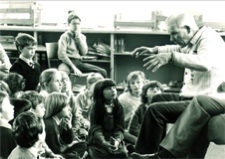
Regardless of how far you carry your nationalism, this common understanding will always be intensely problematic. While storytelling is often seen as a point of origin for conceptions of cultural and national “self”, it is a malleable property, and one that has travelled globally. It is not tied to particular geography or nationalities. Storytelling itself has not confused this issue but rather it is us who have essentialised and misappropratied it in our attempts to champion the craft as valid.
For instance, two quick yet important examples: in the 18th century, Walter Scott fell gladly into correspondence with the Grimm brothers after they contacted him to comment on how Scottish folk tales he had edited and published were almost identical to ones that had been passed down to them from German antiquity. Around the same period, James MacPherson was embroiled in the Ossian scandal, claiming ownership of poems of Scottish antiquity, with one half of a freshly post-union Britain happy to celebrate it, while the other half keen to challenge and dismiss. But of course, Ossian (and Fingal) are Celtic characters more rooted into Irish folk history. However, both Scott and MacPherson proved to reshape Scottish history and a downhearted nation’s sense of self. The hangover for this can be seenin every shortbread tin or clan tartan to line a window in the capital.
The point I am trying to make is that whereas their successes and controversies highlighted an issue in authenticity or exposed the conceptual folly and fallacy of “tradition”, storytelling itself continued on regardless. This is because it is the form itself that is important, the relationship and interaction that it encourages. The form is comfortable being bent and twisted, modified and remade. As such, it is perfectly able to exist as contradiction.It is the fundamental values of storytelling that should be promoted and not merely their historical or cultural value.
In this regard, our critical methodology needs to adapt to mirror the forms that it examines. We should attempt to move the focus from celebrating “authenticity”, and instead merely celebrate contribution. New emerging talents should find fertile soil freshly toiled by the progress and gains of the many Scottish folk revivals. These will prove most healthy when those rising stars the folk purists champion are mixed unceremoniously with voices that academia have no awareness of. There should be no guidelines; these contributors may work in different genres, arts or forms entirely, carrying not a tradition itself, but rather the spirit of the craft that moulded such a powerfully resonant idea in the first place. The stigmatising andessentialising nature of sentimentalised national tradition must be abandoned to allow new contributors to truly create afresh. New talent cannot, and must not, be haunted by old ghosts.
Through establishments such as the School of Scottish Studies and the Scottish Storytelling Centre, the vast wealth of tales carried by the Scottish travellers and the revivalefforts of people like Hamish Henderson (and those in the centuries before), we have re-established the foundations to our indigenous arts and culture. Only, we have found that these are less indigenous than we may have hoped. We simply need to allow ourselves to accept this to build upon the foundations regardless. We must do all we can to ensure that we do not block the flow of progress in anxious attempts to preserve; but instead, learn, observe and create. Interaction must not be expected to necessitate ‘recreation.’
It is essential for a Scotland, independent or otherwise, that this never be the case. The fluid and organic interactions of our arts, cultures and national identities must flow together to ensure this very fact. In the terminology of Hamish Henderson and his many followers, we must “carry stream.”
Greg Whelan

 RSS Feed
RSS Feed
